BY JULIAN D. HIRSCH / Hirsch-Houck Laboratories
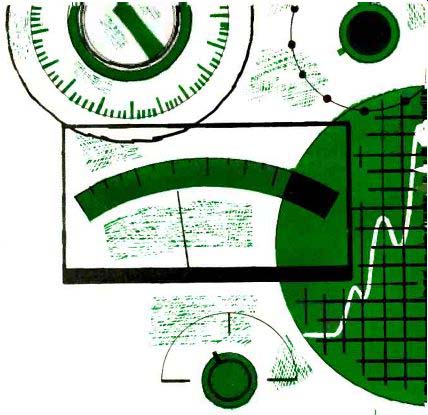
Smaller than the TV servicing market, but potentially highly lucrative, hi-fi servicing requires some special equipment and attention to quality of equipment performance. Here's the kind of test equipment needed and its cost, in order to make hi-fi components not merely work, but work well.
AT one time, a radio service technician needed a minimum of test equipment and technical background to do his job. The old time "screwdriver mechanic," operating with a mixture of experience, intuition, and luck, was able to do an adequate job of servicing AM radios and phonographs.
The advent of TV changed that situation somewhat. Anyone who expected to earn his living in TV servicing had to become familiar with the use of basic test instruments, such as the oscilloscope, v.t.v.m., and sweep generator. Color TV added a new dimension of sophistication to the service technician's work. Many have not been able to make the transition to color-TV service, but those who have are reaping the rewards of that expanding market.
Concurrently with the growth of TV, there has been a smaller but potentially as lucrative market which, for some reason, has hardly been tapped by the service industry.
Component high fidelity, beginning as an enthusiast's hobby more than 20 years ago, has since developed into a multimillion dollar industry.
Many people, when troubles develop in their hi-fi systems, have experienced great difficulty in getting competent service. The local radio and TV shop is generally reluctant to take on the job, and frequently fails to satisfy the customer when it does. A number of shops specializing in hi-fi service have appeared on the scene and partially filled this void, but it is evident that they are too few and far between. Often the customer has no recourse but to ship his ailing component back to the factory or to an authorized service center. This is, at best, inconvenient and often unsatisfactory (did you ever try to describe, in writing, a subtle but irritating distortion ?). When you consider that even a minimal hi-fi system costs as much as a TV set and that many systems represent an investment of $1000 to $2000 or more, it should be evident that there is money to be made in hi-fi servicing. Why, then, have so few service technicians gone into this field? For one thing, most owners of hi-fi components are highly critical. They are not satisfied if their equipment merely "works." They bought it because it offered performance unobtainable in mass-produced packaged radio /phonographs and they want to keep it working as well as it did when it left the factory.
Although hi-fi components are not unduly complex (not at all comparable to a color-TV set, for example), their performance in terms of frequency response, distortion, and sensitivity frequently approaches the state-of-the-art. No one can expect to check out modern hi-fi equipment "by ear" or with a few crude measurements. A number of specialized test instruments and procedures are required to do a thorough job. Many of these are quite expensive and will not be found in the average service shop. It is possible, with a little "know-how," to handle a large percentage of hi-fi service jobs with a minimum investment in test equipment.
Whether a service technician elects to operate on a minimum basis or equip himself for hi-fi servicing depends on his own circumstances. Either way, there is a crying need for more widespread competence in this field.
The basic servicing and troubleshooting procedures for hi-fi components are much the same as for ordinary radios and TV sets and we will not concern ourselves with them at this time. The real problem, for the average service technician, is that of testing, or verifying the performance of a repaired unit, or of adjusting and aligning it to meet its original specifications. Nearly every service shop is already equipped with an oscilloscope, which is used in most audio test procedures, but it is unlikely that many of the other instruments needed will be on hand.
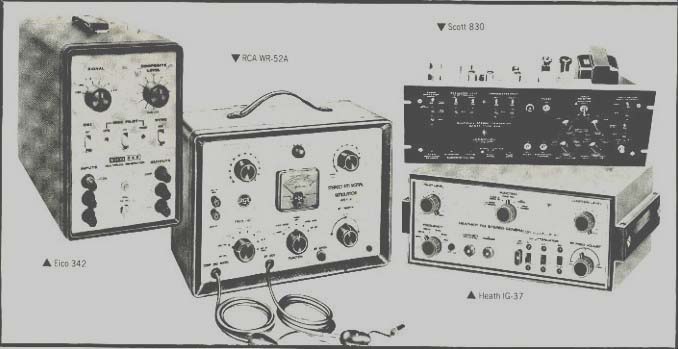
------- A grouping of stereo-FM signal generators for adjusting FM tuners
and receivers.
FM Tuner
We will consider each type of hi-fi component in turn and describe the minimum equipment required for adequate measurement of its performance. In a subsequent article, the specific test procedures will be discussed.
To verify the performance of an FM tuner, it is necessary to measure its sensitivity, distortion, image and i.f. rejection, and dial calibration. In addition, stereo tuners should be checked for channel separation and proper operation of automatic stereo /mono switching circuits. Frequency response may also be checked, although it is unlikely to be affected by normal use or any servicing procedures.
The most important instrument for FM-tuner measurements is a good FM signal generator. Ordinary service instruments are unsuited to this purpose, although TV /FM sweep generators may be used for i.f. and discriminator alignment. The FM signal generator must have calibrated deviation (usually indicated on a meter) up to at least 75 kHz with low distortion, and a calibrated output attenuator capable of setting accurate output levels from 1 microvolt to 100,000 microvolts into a matched 50-ohm load. If it is to be used for stereo measurements, the generator should have a modulation bandwidth of at least 75 kHz. However, it is possible to use specialized stereo test instruments containing their own r.f. generators, in which case the FM signal generator modulation will be in the audio range.
A good FM signal generator is the most expensive piece of test equipment required for hi-fi servicing. One of the least expensive models with suitable characteristics is the Measurements Corp. Model 188 ($700). Other FM generators, such as those made by Hewlett-Packard and Marconi, are designed for laboratory use and have many features not required for hi-fi servicing. Their high price ($1200 to $2000 or more) is not usually justified for service work, but sometimes they can be found on the surplus market for less than $500. Some older laboratory-grade FM generators do not have the modulation bandwidth needed for accurate channel-separation measurements, but are otherwise quite adequate for servicing tuners and receivers.
Stereo-FM measurements require a multiplex generator to develop a standard composite modulating signal from left and right channel input signals. The multiplex signal, including the 19-kHz pilot carrier, modulates the FM signal generator. Several manufacturers produce multiplex generators with built-in r.f. generators (uncalibrated), usually operating around 100 MHz. This eliminates the need for an expensive FM signal generator for ordinary stereo servicing applications, although it is still required for measuring tuner sensitivity and distortion. These instruments are relative ly inexpensive and are quite satisfactory for servicing and aligning stereo-FM tuners.
Typical multiplex generators with built-in r.f. sources include the Heath IG-37 ($80, kit), the Eico 342 ($175), and the RCA WR-52A ($248). When used with a modern FM signal generator such as the Measurements Corp. Model 188, the H.H. Scott Type 830 multiplex generator ($600) provides a stereo-FM signal which fully meets broadcast quality standards.
The IHF Usable Sensitivity measurement requires the use of a distortion analyzer on the audio output of the tuner. The distortion analyzer has a tunable notch filter, which nulls out the fundamental frequency, leaving the r.m.s. sum of the harmonics (plus hum and noise, if present) to be read on a meter as a percentage of the total signal amplitude.
Laboratory-grade distortion analyzers, such as the Hewlett-Packard Model 331A ($650) are not really needed for tuner measurements, where distortion rarely goes below 0.5%, although they are exceptionally convenient and rapid to use. The inexpensive Heath IM-58 ($65, kit) is capable of making any distortion measurements necessary in hi-fi servicing, in amplifiers as well as tuners. Additional flexibility is offered in the Eico Model 902 ($250), which also includes an intermodulation analyzer and a sensitive a.c. v.t.v.m., and in other respects is similar to the Heath IM-58.
Although an inexpensive audio oscillator might be used as a modulating source for some tuner measurements, it is necessary to maintain a constant audio level (within +1 dB or better) and to have accurate frequency calibration when making frequency-response measurements on any audio component. A good investment is a low-distortion audio generator, such as the Heath IG-72 ($47, kit or $70, wired) or the Eico Model 378 ($60, kit or $80, wired). These instruments cover a range from 10 Hz to 100 kHz, with accurately resettable switch-selected frequencies, uniform metered output level, and distortion less than 0.1%. Some continuously tuned laboratory-grade oscillators, including the Hewlett-Packard Model 204-C ($250) and the General Radio Type 1310-B ($295) are also well-suited for high-quality audio measurements.
Testing any hi-fi component requires that audio voltages be measured over a wide range of amplitudes, from perhaps 1 millivolt to 20 or 30 volts. Ordinary service multimeters are lacking in sensitivity and frequency response. Inexpensive a.c. v.t.v.m.'s, such as the Heath IM-38 ($42, kit or $58, wired), Eico Model 250 ($60, kit or $90 wired), or RCA WV-76A ($90), are satisfactory for this purpose. Greater accuracy, typically 1% as compared to 3% for the lower-priced meters, plus wider frequency bandwidth are offered in laboratory-grade meters, such as Singer (Bellantine)
Model 303-01 ($335), the Hewlett-Packard Model 400E ($335), and General Radio Type 1808 ($295). AM Tuner Every service technician is already equipped to work on AM tuners, which are included in many stereo receivers, and sometimes in separate component AM-FM tuners. No special instruments are required and, with the present trend toward using ceramic if. filters, it should not be long before an AM tuner alignment will consist only of a front-end tracking adjustment.
When an FM or AM tuner is part of a complete receiver, it is preferable to make all measurements of its audio output at the tape-recording jacks, which are provided on practically all receivers. This eliminates the effect of tone-control response, or audio distortion, on the measurement of tuner performance.
Amplifier
Functionally, amplifiers can be broken down into two distinct sections, on which different measurements must be made. The preamplifier includes the input switching, phono equalization, tone controls and filters, and volume-control functions. The power-amplifier section usually has no controls or external adjustments (except for speaker switching) and amplifies the low-level output of the preamplifier to drive the speakers. Sometimes the preamplifier and power amplifier are physically separate, but more often they are combined in a single unit, frequently with tuners included to form a complete receiver.
Preamplifier measurements include frequency response, tone-control characteristics, phono and tape-head equalization accuracy, distortion, hum and noise, and crosstalk between inputs. Stereo crosstalk (between channels of the same program source) is rarely great enough to be audibly significant.
The basic instruments for audio measurements include an audio signal generator, with metered output and attenuators capable of controlling the output level between 1 millivolt and several volts; an a.c. v.t.v.m. with a similar range; an oscilloscope; and a distortion analyzer. The instruments suggested for testing tuners are also suitable for amplifier measurements.
Power-amplifier tests differ somewhat from the basic frequency-response measurements made on tuners and pre-amplifiers. The frequency response of a power amplifier--even an inexpensive one--is usually quite flat across the audio range from 20 to 20,000 Hz and there is little point in measuring it. We are more concerned with determining how much power can be delivered at different frequencies and at how much distortion. Hum and noise are important factors, since they will not be affected by volume controls or filters in the preceding preamplifier section. Instability under various conditions of load or drive is a common fault, which can occur because of a component failure. Oscillations outside the audio range may not be heard as such but can affect the sound and in an extreme case even damage a speaker. A stability check is an important part of the checkout procedure.
A low-distortion audio generator, such as those previously described, is ideal for driving a power amplifier. It will be necessary to provide suitable resistor loads for the two outputs, replacing the speakers while making measurements.
Although series and parallel combinations of standard wire-wound power resistors can be used to make 8-ohm loads, this tends to be clumsy. While most amplifiers deliver less ...
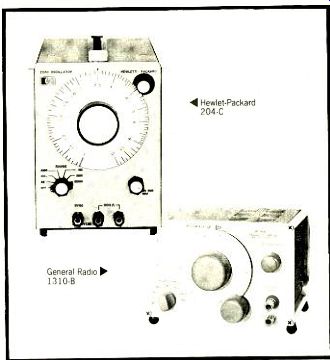
-------- General Radio; 1310-R Hewlet-Packard 204 –C. A pair of audio
oscillators that can be used to supply audio test signals.
... than 30 watts continuous output per channel, there are some capable of 50 to 60 watts or more.
We have found an excellent solution to the problem of dissipating this much power safely in the use of a compact, high-wattage precision resistor manufactured by Dale. The Type RH-50, listed in the Allied Radio and other mail-order catalogues, is available in an 8-ohm value, with a I% tolerance, for about $2.50. When it is mounted to a metal chassis by its integral "ear," it can dissipate 50 watts without damage or undue change of value. At least two resistors will be needed, for the two stereo channels. We have found it convenient to use two 8-ohm resistors with a switching arrangement to connect them in series or parallel when 16-ohm or 4-ohm loads are required. If they are to be used continuously at high power levels, they may be suspended in mineral or transformer oil, and will safely dissipate several hundred watts for sufficient time to make any necessary measurements.
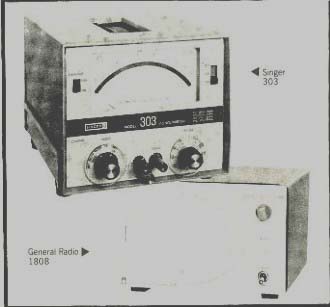
--------- Laboratory-grade high-sensitivity a.c. voltmeters for signal-level
measurements.
The Heath IM-48 audio analyzer ($69, kit) combines an IM analyzer (not really needed if a harmonic-distortion analyzer is available) with an a.c. v.t.v.m. and built-in load resistors so that it can serve as a direct-reading wattmeter. Although it is convenient to use, another load must be provided for the second channel and its built-in load is only rated at 25 watts continuous dissipation. All in all, we feel it is more convenient to build a two-channel load with adequate dissipation capability and measure the voltage across the load with a v.t.v.m. to determine power output.
The rated power of an amplifier can be obtained only when the proper a.c. line voltage is available. A drop of a couple of volts in the supply voltage can have a disproportionate effect on the maximum undistorted output power.
It is important to continuously monitor the line voltage with an accurate meter. The RCA Model WV-120A ($18.50) is an inexpensive line monitor with sufficient accuracy.
When driving a powerful amplifier to its maximum, it is not uncommon for the line voltage to drop several volts. Not only must it be monitored, but there must be some means of maintaining the proper voltage (normally 120 volts).
---------
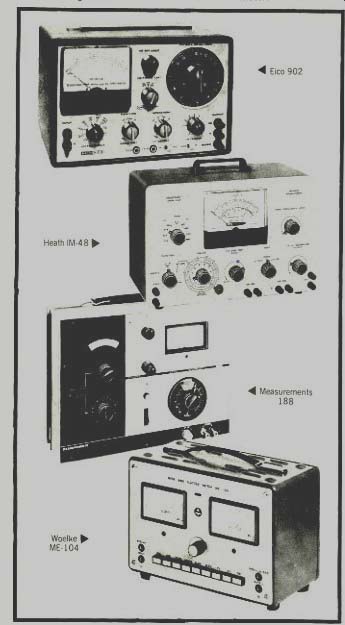
------Pair of distortion meters, an FM signal generator, and a wow and
flutter meter.
--------
A variable autotransformer, such as the General Radio Type W-5M Variac ($31) or the Superior Type N21 ($39) is the simplest way to control the line voltage. Automatic regulators of the saturable-reactor type should not be used unless they are designed to deliver a sinusoidal output waveform.
Record Players
Aside from correct operation of the record-dropping and indexing mechanisms, record players are required to operate at the correct speed, without excessive wow, flutter, or rumble. If adjustable anti-skating compensation is provided this should be set up properly for the stylus force in use.
Speed is readily checked with an inexpensive stroboscope disc, viewed under fluorescent or neon light. For wow or flutter measurements, special test records and a wow and flutter meter are required. Wow and flutter are normally measured with a 3000-Hz test tone, since the human ear is most sensitive to speed fluctuations in that frequency range. Test records providing this signal, recorded with very low wow and flutter, include the STEREO REVIEW SR12 ($4.98) and the CBS Labs BTR-150 ($10). The SR12 record also has a music flutter test with four passages of piano music recorded with successively greater amounts of flutter. This is useful for subjective evaluation of turntable flutter, without using a wow and flutter meter.
There are several makes of wow and flutter meters available. The Woelke ME-104 ($365) is imported by Gotham Audio Corp. The W.H.M. Model 3 ($190) is imported by ReVox Corp. Several more refined (and expensive) meters are made in this country by Data Measurements Corp. (formerly known as Micom). Rumble may be judged subjectively by listening to the silent groove bands of the CBS Labs BTR-150 record or to the special rumble test band of the STEREO REVIEW SR12 record. Unless the listening is done in the normal environment of the system, or at the very least with speakers having the same or better low-frequency response, this may be of limited value. Speaker and room characteristics have a strong affect on audible rumble.
Standard NAB rumble measurements are referred to a level corresponding to a recorded velocity of 1.4 cm /s at 100 Hz, or 7 cm /s at 500 Hz, with RIAA low-frequency playback equalization (slightly modified at low and high frequencies to eliminate the effects of other noise sources). Unfortunately, the records named do not have a recorded reference level tone, but it can be determined with sufficient accuracy from some of the recorded tones of the CBS Labs BTR-150 or STR-100 records.
A playback preamplifier, with RIAA low-frequency equalization, is needed when making rumble measurements. There are many standard preamplifiers that are suitable for this purpose. Used monophonic preamplifiers of excellent quality can often be purchased for a fraction of their original cost if a stereo preamplifier is not readily available. Since this measurement may be made on only one channel, a monophonic preamplifier is perfectly satisfactory.
Under the best of conditions, turntable--rumble measurements are difficult to make with accuracy and repeatability.
However, when checking out a turntable after servicing, it is only necessary to know the approximate rumble, which is easily determined with sufficient accuracy using simple equipment-or even with no equipment other than a silent groove test record.
Phono Pickups
The tonearm (with the cartridge installed) should be checked for correct stylus overhang, tracking force, and anti-skating compensation, if this feature is provided. Many arms, particularly those in lower priced record changers, have no provision for cartridge positioning (overhang) or anti-skating. Usually, when the cartridge overhang is adjustable, the record-player manufacturer provides a jig or reference point to establish the correct mounting position for minimum tracking error. The mounting instructions for separate tonearms, if followed carefully, accomplish the same end.
If no other means of checking anti-skating compensation is available, the arm manufacturer's recommendations should be followed. Frequently, a more effective adjustment can be made with the aid of the special test bands of the STEREO REVIEW SR12 test record.
With a pickup tracking at several grams, almost any of the numerous stylus-force gauges on the market can be used to set the force. However, most good hi-fi pickups track at forces in the 1-to 3-gram region and an accurate balance-type gauge should be used.
The British-made Transcriptors gauge (about $18) is very accurate, within 0.05 gram up to 6 grams, but is relatively cumbersome to use. The AR gauge ($1) is excellent for forces up to 3 3/4 grams, in 1/4 gram steps. Other suitable balance gauges are made by Robins and Almega.
Before checking a cartridge that has been previously used, examine its stylus under a microscope for damage.
Failure to do this could damage an expensive test record. The Robins PM-1 stylus microscope ($1.90) is satisfactory for this purpose.
The CBS Labs STR-100 test record ($8.50) has frequency-response test bands, with voice announcements identifying spot frequencies from 20 to 20,000 Hz. The a.c. v.t.v.m. used for other frequency-response measurements, and the preamplifier used in rumble measurements, can be used when checking cartridge response and crosstalk. If possible, the high-frequency phono equalization should be disabled, since the CBS record is cut with constant velocity and the high-frequency amplitude will be greatly reduced if the preamplifier has equalization. Even if this is not practical, conversion data supplied with the record permits its use with an RIAA-equalized system. This technique will have to be used in compact systems where the cartridge output cannot be measured separately from the amplifier. In this case, the tape outputs of the amplifier are used as measurement points, with due allowance for phono equalization.
Tape Recorders
Tape-recorder testing requires an audio generator, a.c. v.t.v.m., oscilloscope, and a wow and flutter meter. All of these can be the same types used for testing other components previously discussed.
In addition, a few specialized accessories are needed. Tape-speed measurement requires a special stroboscope wheel, held against the moving tape and viewed in the same manner as for a disc stroboscope. The Robins TW-1 ($7.00) is one such tape strobe. A tape-head demagnetizer should be used on the heads before playing any of your expensive test tapes on a machine whose operating history is unknown. There are many types of demagnetizers and other tape accessories, such as splicers, which may be purchased according to your specific requirements.
Special test tapes are required to align heads and check the performance of a tape recorder. The most widely accepted standards in this country are the Ampex professional alignment tapes. You will need the Ampex 31331-01 (3 3/4 in/ s) and the 31321-04 (7 1/2 in/s) alignment tapes ($22 each). If you have a wow and flutter meter and wish to check a tape recorder, you will also need the Ampex 31336-01 (3 3/4 in /s) and 31326-01 (7'/2 in/ s) flutter tapes ($22 each). It is possible to check flutter by recording a 3000-Hz tone on a blank tape and playing it back into a flutter meter, but this does not give accurate results obtainable with a special tape, since the recorder introduces flutter both in the recording and playback processes, which cannot be separated from each other in the measurement process.
At present there are few test tapes available for cassette recorders. Their over-all record /playback response can be measured in the same manner as with reel-to-reel recorders. Alignment cassettes have been made by Philips and BASF, but have had limited distribution in this country and are quite expensive.
Although this array of specialized test equipment and accessories for hi-fi testing may seem formidable, it is difficult to adequately check out the performance of modern hi-fi components (as distinguished from mass-produced packaged units) without them.
The actual test procedures required will be described next month, together with hints on avoiding some common errors leading to incorrect results. Do not be concerned with the apparent complexity of the tests. In most cases, a few spot checks will establish the condition of the unit being tested, without the need for a full series of measurements. Simplified procedures, involving a minimum of instruments, will also be described, for the benefit of the service technician whose volume of hifi business does not warrant a major investment in test equipment.
(Concluded Next Month)
Also see: TEST EQUIPMENT--Product Report